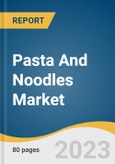The global pasta and noodles market size is expected to reach USD 109.52 billion by 2030. The market is expected to expand at a 3.5% CAGR from 2023 to 2030. The demand for ready-to-cook products is propelled by the rising adoption of western and international cuisines across the globe on the back of the growing demand for convenient food products. The presence of healthier options such as rice mixes with superfoods and nutrient-dense ingredients with a shift towards higher protein and higher fiber intake in pasta and noodles will contribute to growth.
Increasing inclination toward healthy eating is driving the demand for gluten-free, fat-free, and vegan pasta and noodles. Growing consumer interest in ethnic cuisines is driving innovation in the category, with wider availability on the shelves of ethnic references, such as exotic rice and noodles, which are proving popular among consumers across the globe, particularly in China and the U.S. The trend towards premium references has created growth in global sales as consumers seek to experiment with flavors and high-quality ingredients in pasta and noodles.
The instant pasta and noodles segment accounted for a significant share of the global revenue pie for 2021 and is expected to maintain dominance over the forecast period. An increasing global workforce and consumers with busier lifestyles are driving demand for convenient options, such as chilled pasta and instant noodles, which save time in meal preparation. Nowadays, consumers shopping more frequently, buying less per trip is expected to boost sales of instant pasta and noodles.
The offline channel contributed a majority of the share to become the largest division in the global revenue in 2021. The offline stores including supermarkets, hypermarkets, grocery stores, and convenience stores provide dedicated shelf spaces that offer different varieties of pasta and noodles. The increase in penetration of major supermarkets & hypermarkets across the globe is gaining the attention of consumers for the purchase of pasta and noodles which is expected to provide significant growth opportunities in the upcoming years.
The market is consolidated with the presence of a large number of international players and few regional players.
This product will be delivered within 1-3 business days.
Increasing inclination toward healthy eating is driving the demand for gluten-free, fat-free, and vegan pasta and noodles. Growing consumer interest in ethnic cuisines is driving innovation in the category, with wider availability on the shelves of ethnic references, such as exotic rice and noodles, which are proving popular among consumers across the globe, particularly in China and the U.S. The trend towards premium references has created growth in global sales as consumers seek to experiment with flavors and high-quality ingredients in pasta and noodles.
The instant pasta and noodles segment accounted for a significant share of the global revenue pie for 2021 and is expected to maintain dominance over the forecast period. An increasing global workforce and consumers with busier lifestyles are driving demand for convenient options, such as chilled pasta and instant noodles, which save time in meal preparation. Nowadays, consumers shopping more frequently, buying less per trip is expected to boost sales of instant pasta and noodles.
The offline channel contributed a majority of the share to become the largest division in the global revenue in 2021. The offline stores including supermarkets, hypermarkets, grocery stores, and convenience stores provide dedicated shelf spaces that offer different varieties of pasta and noodles. The increase in penetration of major supermarkets & hypermarkets across the globe is gaining the attention of consumers for the purchase of pasta and noodles which is expected to provide significant growth opportunities in the upcoming years.
The market is consolidated with the presence of a large number of international players and few regional players.
Pasta And Noodles Market Report Highlights
- Asia Pacific is expected to contribute a significant share to become the largest segment in 2021 owing to increasing acceptance of western & international cuisines and convenient food products among consumers in China, India, and Japan
- The frozen & canned pasta and noodles is anticipated to grow at a CAGR of 3.1% as the consumption of shelf-stable and convenient food products increased during the pandemic
- The online segment is anticipated to grow at the fastest CAGR of 5.4% owing to the availability of a dynamic range of pasta and noodles from international and local brands online
This product will be delivered within 1-3 business days.
Table of Contents
Chapter 1. Methodology and Scope
Chapter 2. Executive Summary
Chapter 3. Pasta and Noodles Market Variables, Trends & Scope
Chapter 4. Consumer Behavior Analysis
Chapter 5. Pasta and Noodles Market: Product Estimates & Trend Analysis
Chapter 6. Pasta and Noodles Market: Distribution Channel Estimates & Trend Analysis
Chapter 7. Pasta and Noodles Market: Regional Estimates & Trend Analysis
Chapter 8. Competitive Analysis
List of Tables
List of Figures
Companies Mentioned
- Nestlé
- Barilla Group
- ITC
- The Kraft Heinz Company
- Unilever
- Toyo Suisan Kaisha, Ltd.
- Nissin Foods Holdings Co., Ltd.
- Campbell Soup Company
- Conagra Brands, Inc.
- TreeHouse Foods, Inc.
- Ebro Foods, S.A.
Methodology

LOADING...
Table Information
| Report Attribute | Details |
|---|---|
| No. of Pages | 80 |
| Published | July 2023 |
| Forecast Period | 2022 - 2030 |
| Estimated Market Value ( USD | $ 83.49 billion |
| Forecasted Market Value ( USD | $ 109.52 billion |
| Compound Annual Growth Rate | 3.5% |
| Regions Covered | Global |
| No. of Companies Mentioned | 11 |









